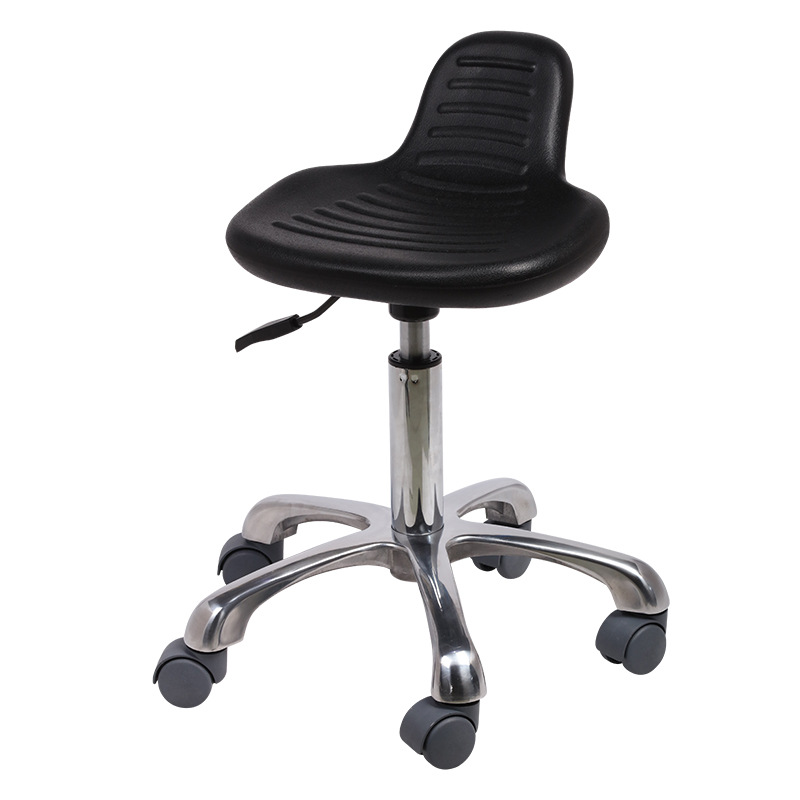What is an Anti-static PU Chair?
An Anti-static PU Chair is a specialized office or task chair designed to prevent the buildup
and discharge of static electricity. It's a critical piece of equipment in environments
where static-sensitive components are handled.
Anti-static (ESD - Electrostatic Discharge): This means the chair is constructed with materials
that allow static electricity to flow safely to the ground, rather than building up on a person's body
and then discharging onto a sensitive electronic component.
PU (Polyurethane): This is the material used for the seat and backrest.
PU is a popular synthetic leather that is durable, easy to clean, and cost-effective.
It provides a consistent surface that can be engineered to have anti-static properties.
Key Features and How They Work
Conductive Materials: The chair incorporates conductive elements, often in the form of carbon fibers
or other conductive compounds, mixed into the PU coating, the casters (wheels), and the chair's base.
Continuous Path to Ground: The system works by creating a continuous path for static electricity to flow:
The user sits on the conductive PU seat.
Static charge travels from the user, through the seat, down the conductive chair frame.
It passes through the conductive casters (wheels) and finally dissipates into a conductive (typically grounded) floor.
ESD Casters: These are not your standard office chair casters.
They are specially designed with conductive materials (often carbon-filled) to complete the grounding path.
Static-Dissipative Finish: The entire chair, especially the PU surface, is treated or formulated to have a specific electrical resistance
—not too conductive (which could cause a short circuit) and not too insulating (which would allow static buildup).
It's "static-dissipative," meaning it slowly and safely bleeds away the charge.
Primary Applications: Where Are They Used?
These chairs are essential in any industry where a static shock can damage expensive equipment or cause safety hazards.
Electronics Manufacturing & Assembly: For building and handling circuit boards, microchips, hard drives, and other sensitive components.
Telecommunications and Data Centers: For technicians working on servers, routers, and network hardware.
Laboratories and R&D Facilities: Especially in electronics, biotechnology, and pharmaceutical labs where precision instruments are used.
Aerospace and Defense Manufacturing: For assembling guidance systems, avionics, and other sensitive electronic equipment.
Medical Device Manufacturing: Where electronic implants or diagnostic tools are produced.
Cleanrooms: Many anti-static PU chairs are designed to be low-particulate and suitable for cleanroom environments.
Advantages and Disadvantages
Advantages:
Protects Sensitive Equipment: The primary benefit is preventing costly damage from ESD, which can often be invisible and cause latent failures.
Durability: PU is generally more resistant to cracking, peeling, and staining than real leather or fabric, and is easy to wipe clean.
Cost-Effective: Compared to chairs with full-grain leather or specialized cleanroom fabrics, PU is an affordable and effective material.
Comfort: PU chairs often provide a good balance of support and comfort, similar to standard office chairs.
Disadvantages:
Breathability: PU is not a breathable material. It can trap heat and moisture,
making it less comfortable for long sits in non-climate-controlled environments compared to mesh chairs.
Long-Term Durability: While durable, high-quality PU can eventually crack or peel over many years,
especially if exposed to direct sunlight or harsh chemicals.
Requires a Conductive Floor: The chair's anti-static properties are useless if it's used on a standard carpet or vinyl floor.
It must be used in conjunction with an ESD floor (conductive tile, epoxy flooring, or with a grounded ESD mat).
Conclusion
An Anti-static PU Chair is a non-negotiable, purpose-built piece of ergonomic furniture for any ESD-protected area. It effectively bridges the gap between user comfort and the critical need to protect multi-thousand-dollar electronic components from invisible static damage. When paired with a proper ESD flooring system, it forms a fundamental part of a comprehensive electrostatic discharge control program.


